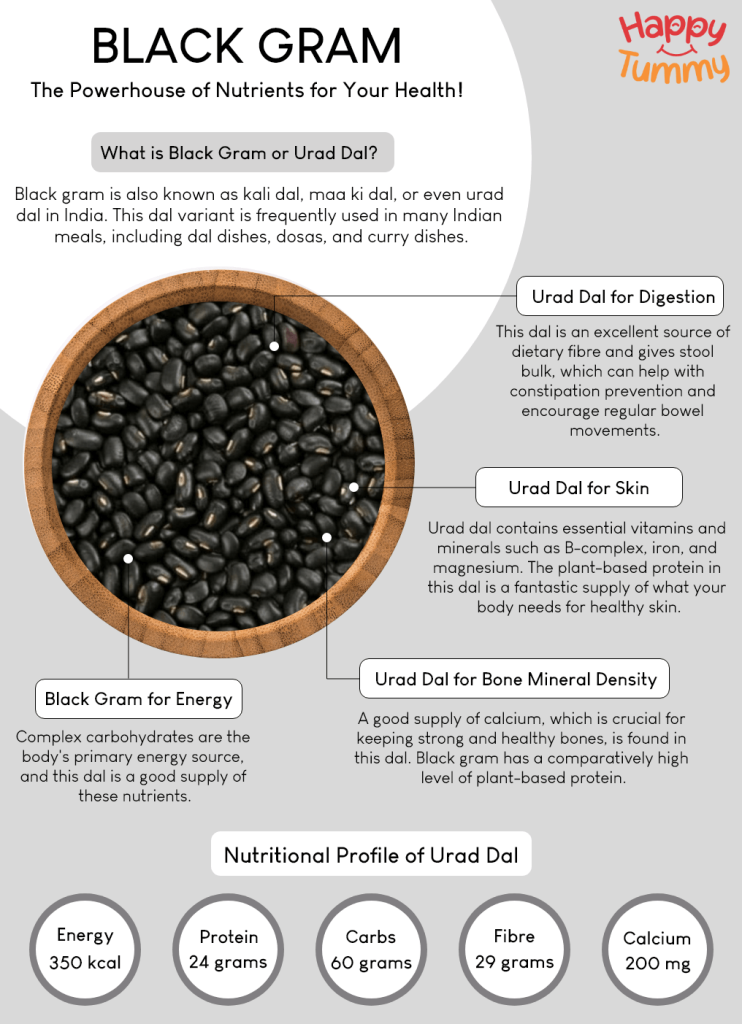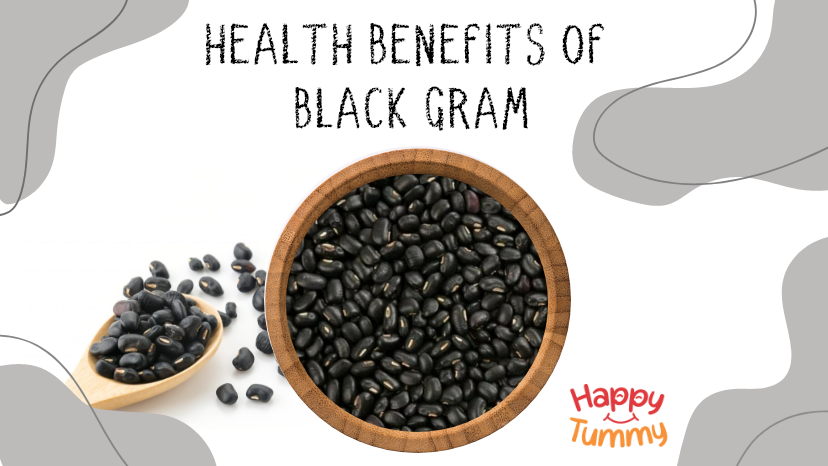Table of Contents
What’s in for dinner today? It is a common question that is asked every day in almost every Indian kitchen. And to surprise, most days, the families, especially kids, need something different and exciting to eat. Irrespective of what is cooked as a sabzi, one thing is majorly a part of every Indian culture – Dal.
In India, the recipe for this versatile dish does not just vary from region, culture or state, but it differs from one person in the house to another.
That is the speciality of these excellent legumes, and today we are discussing one such that is offered cooked as a special feast – black gram or urad dal (popularly known as dal makhani).
These tiny, ebony-coloured dal may have an inconspicuous appearance, yet they hide a potent store of nutrients and well-being advantages just waiting to be uncovered. Urad dal has been vital in innumerable household recipes, adored street dishes, and international culinary customs. And if you are thinking you can only use it for making makhani dal, there is a lot for you to know about this dal.
So, let’s begin.
What is Black Gram or Urad Dal?
Black gram is also known as kali dal, maa ki dal, or even urad dal in India. It is a native of the Indian subcontinent, is also grown in other regions of Asia, and is the unsung hero of the legume world.
Urad dal is a small, oval-shaped bean with a creamy-white interior and a black or dark brown exterior. It is one of the dals praised in Indian cooking for its adaptability and is used in various savoury and sweet dishes.
This dal variant is frequently used in many Indian meals, including dal dishes, dosas, and curry dishes. It is prized for its rich, nutty flavour and capacity to take on the aromas and spices of other ingredients when cooked.
Nutritional Profile of Urad Dal
There is no denying how essential dals are for our culture. When discussing good nutrition, we always go back to basics and consider cooking a dal. It is no different for this excellent legume. The table below contains urad dal nutrition information that will convince you how great it is. The nutritional profile is for 100 grams of maa ki dal [1].
| Components | Amount |
| Energy | 350 kcal |
| Protein | 24 grams |
| Carbohydrates | 60 grams |
| Fibre | 29 grams |
| Calcium | 200 mg |
Black Gram Benefits for Health

The vital nutrients protein, dietary fibre, vitamins, and minerals are abundant in black gram, which is nutrient-rich and nutrient-dense.
Additionally, it has virtually minimal fat and no cholesterol. This dal provides nutritional and health advantages in addition to its culinary usage.
Here are a few of the potential health advantages of urad dal for your reference:
1. Urad Dal for Digestion
These days, digestive issues are a typical family issue. At least one family member may experience constipation or other gastrointestinal problems at any given moment.
Not eating on time and, to some extent, lifestyle are the leading causes. But don’t panic; by making a few dietary changes, you can overcome these digestive problems and make your tummy happy tummy.
Take a brief Digestive Quotient Test if you are concerned about your digestive health to determine how your stomach functions.
This dal is an excellent source of dietary fibre and gives stool bulk, which can help prevent constipation and encourage regular bowel movements [2]. It also helps soften the stool, making it simpler to transit through the digestive system.
Moreover, many enzymes found in maa ki dal help break down proteins into simpler pieces that are easier to digest and allow for the absorption of vital amino acids.
Also, the soluble fibre in kali dal can function as a prebiotic by feeding the good bacteria in the intestines, which keeps the tummy happy tummy. For appropriate digestion and general digestive health, the gut microbiota must be in a balanced state.
You may make meals like dal, a popular and nutrient-dense Indian dish, to integrate this versatile ingredient into your diet for better digestion. Also, using its flour in dishes like dosa or idli is another choice.
Next time you make Maa ki Dal, check its fibre content on My Meal Plan. You will be surprised and happy to know you are serving your family a fibrous-rich meal. To make it more fibrous, serve it with roti or parantha made with Aashirvaad Multi Millets Mix. It is also an excellent option for supporting overall digestive health.
2. Black Gram for Energy
Energy is the one thing our bodies require to make it through the entire day. From getting out of bed in the morning to getting back into it at night, you need it for EVERYTHING.
Do you know you can get this from kali dal [3]? If you don’t, read along.
Complex carbohydrates are the body’s primary energy source, and this dal is a good supply of these nutrients.
Additionally, cells use the glucose created when carbs are broken down as fuel. As a result, eating meals high in carbohydrates, like kali dal, can provide an ongoing and progressive release of energy.
Also, urad dal has a comparatively high protein content for a legume. Building and rebuilding muscle requires protein.
Your diet can help you achieve the protein requirements for maintaining energy levels. The iron in this dal is a mineral needed for synthesizing haemoglobin, a protein in red blood cells that aids in transporting oxygen throughout the body. Eating this dal may keep your body’s energy levels sufficient.
3. Urad Dal for Bone Mineral Density
Healthy bones are always a topic for discussion, especially if little kids and older people are involved. So, how come it is here in black gram’s article? It is because it is an excellent source of bone mineral density. Let’s check it out.
A good supply of calcium, which is crucial for keeping strong and healthy bones, is found in this dal. Our bodies need sufficient calcium intake for mineralization and density since calcium is a significant portion of bone tissue.
Similarly, phosphorus, another crucial mineral for healthy bones, is also present in kali dal. To create and mend bones and maintain bone density, phosphorus collaborates with calcium, making it strong and healthy.
At the same time, your bones must have protein, and black gram has a comparatively high level of plant-based protein. Therefore, an adequate protein intake is required to develop and maintain bone structure, which you can easily get by including this dal in your diet.
4. Urad Dal for Skin
Another important thing you will love to include this dal in your diet is its excellent benefits on your skin [4]. Yes, you read that correctly.
The plant-based protein in this dal is a fantastic supply of what your body needs for healthy skin. Protein helps to heal damaged skin tissues and keeps the skin flexible, giving it a youthful and firm appearance. It also encourages the creation of collagen.
Also, urad dal contains essential vitamins and minerals such as B-complex, iron, and magnesium. These nutrients help the skin’s overall health by increasing circulation, reducing dryness, and assisting in maintaining a healthy skin barrier.
This dal is also a good source of vitamin C and other antioxidants and phytonutrients. These antioxidants aid the skin’s defense mechanism against the impacts of free radicals, which can hasten the ageing process and create wrinkles and other skin issues.
Furthermore, black gram has several anti-inflammatory substances. Skin diseases like acne can sometimes be treated by reducing inflammation.
What else do you do with it besides eat? It can be used to exfoliate the skin.
When crushed into a fine paste and used on the skin, it can help remove dead skin cells, unclog pores, and create a smoother, more luminous complexion.
Scrubs or face masks can be used to moisturize the skin. Natural oils in it assist in hydrating and nourishing the skin, giving it a silky, supple appearance.
Conclusion
In conclusion, black gram has several advantages outside of the kitchen. This inconspicuous bean has a wealth of nutritional benefits for your health, from promoting healthy digestion to boosting bone density and improving skin condition.
It has shown to be a valuable and adaptable addition to your diet and skincare regimen, whether consumed as a hearty bowl of dal, a crisp dosa, or included in various recipes.
Let us enjoy the numerous facets of urad dal. This modest substance continues to empower us on our quest for a better and more vibrant existence as we savour its plethora of flavours and nourishment.
FAQs
Yes, there are no issues in eating this day regularly. However, you should include it in different forms to avoid getting bored of eating it as just dal.
Yes, urad dal is very healthy and offers numerous health benefits, including digestion, bone and skin health.
















